Acelec Model One Loudspeakers by David Abramson

 “Man these things are heavy!” was my first thought when the UPS guy delivered them. He agreed. “Gotta be good speakers, right?” My UPS guy knows. In audio, everyone knows heavy=good. I felt reassured. There are basically two schools of thought in speaker design; “Resonances happen, so be civil to them and train them up in a way consonant to the music” and ‘The only good resonance is a dead resonance.” The first school of thought appeals to poets, and the second, to engineers. I Kid! I kiiiiid! Sort of.
“Man these things are heavy!” was my first thought when the UPS guy delivered them. He agreed. “Gotta be good speakers, right?” My UPS guy knows. In audio, everyone knows heavy=good. I felt reassured. There are basically two schools of thought in speaker design; “Resonances happen, so be civil to them and train them up in a way consonant to the music” and ‘The only good resonance is a dead resonance.” The first school of thought appeals to poets, and the second, to engineers. I Kid! I kiiiiid! Sort of.
Upon inspection, I realized I was dealing squarely with a product of the latter school of thought and with what effectively are solid blocks of aluminum, except they aren’t. Like a Magico and/or YG and/or other ultra-speakers, the likes of which only Jay at Jay’s Audio Lab has an informed opinion on (or can lift), the entire Acelec speaker is comprised of 15-millimeter thick bituminized aluminum panels bonded to one another with a dampening compound Acelec calls a “rubber-like adhesive.” Yup, in contradistinction to every single BBC monitor and my own Devore and Xavian ‘reference’ speakers, Acelec’s design goal here was very much born of the ‘only good resonance is a dead resonance” school. In addition, these 35 pounds a piece dense aluminum bricks are also internally damped, and in conjunction with their rockablock enclosures, this means they seem about as resonant as a pile of bricks cemented together and coated in rubber.
Acelec’s web info aptly illustrates the idea behind the enclosure by pointing out that a cracked church bell loses its beautifully resonant tone due to the loss of unity of the material, and this is exactly the behavior they capitalize on in designing the Model One; i.e., the box is heavy and non-unified (cracked) in that there is dampener between the panels and is internally damped as well. (Literal) Black box warning: Do NOT do the knuckle rap test on these black boxes.
 The Acelecs also feature a Mundorf AMT (Air Motion Transducer), which works based on the (ultra) rapid compression of a thin folded membrane, is much lighter than a conventional dome tweeter, and has a larger radiating area. It also happens to be highly directional. (More about the fortuitous goodness which results from this particular characteristic later). The 84db efficient Model One uses an approximately 6-inch Scan-Speak mid-woofer, and the rated low-frequency response is 45Hz.
The Acelecs also feature a Mundorf AMT (Air Motion Transducer), which works based on the (ultra) rapid compression of a thin folded membrane, is much lighter than a conventional dome tweeter, and has a larger radiating area. It also happens to be highly directional. (More about the fortuitous goodness which results from this particular characteristic later). The 84db efficient Model One uses an approximately 6-inch Scan-Speak mid-woofer, and the rated low-frequency response is 45Hz.
The company makes the point that this rear-ported speaker is designed for monitor-like linearity (they, in fact, make a dedicated studio monitor, the Model Two) and is likely to work best in whatever passes for a ‘small to medium’ sized room (are we in NYC or Wisconsin?). By design, it can also purportedly work well in corners or close to room boundaries and comes supplied with cute foam bungs for the ports should you wish to further tame the bass-iness in close boundary applications.
Set up (after hurting my back moderately)
I set the Acelecs up on a pair of very sturdy kitty-litter-filled B&W reference stands (I will never reveal my preferred brand of litter, but it’s grey and available in limited quantities at Walmart) approximately 7.5 feet apart, measured from tweeter to tweeter and approximately 16 to 18 inches out from the front wall (measured from the back of the speaker enclosure). It took me a few days to determine that due to the directionality of the AMT tweeter (see pic below), the Model One performed best when toed in a fair amount and spaced a bit wider than some other smaller speakers of my acquaintance, like the Dali Oberon 5.
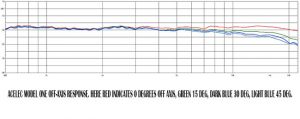
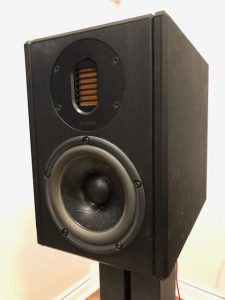
Of note, this directionality later turned out to be a major plus in my room, as I had been struggling with acoustic issues such as sidewall asymmetry imposed upon me by the inability to place speakers in this room in almost any other way than one of the most asymmetrical, and other such issues. Then I found their preferred amp. Fortunately, it was my trusty steed; Lejonklou’s beautifully balanced minimalist Boazu. I didn’t have a ton of other amps on hand, but I DID have the wonderful (depending on context) First Watt SIT 3 and the also wonderful and versatile Linear Tube Audio MZ3 preamp/headphone amp. The SIT 3 proved, well, less dynamic and a bit too ‘edgy’ all around with the Acelecs, whereas the Boazu, on the contrary, even given their 84dB sensitivity, was effortless and even-handed. The SIT 3, I’ve found, can be very particular about its dance partners, so this really doesn’t say much about its overall qualities, which, with the right partner, are invitingly lifelike. Then I found their preferred wires; the superb, beautifully built AAC (Audio Art Cable) Statement e SC Cryo speaker cables on loan from the fine ‘n dandy (yep, he’s both at once) Rob Fritz of Audio Art, the self-same man who distributes the Acelecs along with the whole Sonnet line. Yes, the Cryos was a superbly built next-level cable from Rob that elevated my system in every way, and I was pleased to have them in-system for the duration of this review and quite possibly beyond… (I may buy them!)
As soon as I lashed everything together with said wires and hit play, I knew we were in for a Boazu-fest with the Acelecs. In fact, I had suspected the Boazu and Acelec might be fast fellows as I have it on some authority Fredrik Lejonklou’s favorite speakers are from Klangedang (the Model T1). They are roughly the size, efficiency, and impedance of the Acelec. The Boazu was, therefore, electrically speaking, if not geographically, on home turf here!
The Opposite of Silence
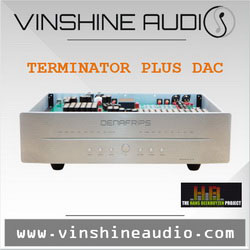 Game of Thrones Suite was a veritable showcase for the dimensionality, depth, and texture of this remarkable transducer. Yes, the Acelec is a transducer. That’s the word I kept contemplating while they played. In fact, I can recall having heard such texture on strings from a few speakers past, but I can’t recollect hearing such extreme perceived freedom from any cabinet resonance or coloration with prior speakers in-house. Mind you, I LIKED some of those resonances in that they contributed to some mid-bass warmth at times and so forth, but the contrasting lack thereof was obvious here at the start, and this made for a uniquely clean and precise window into the recorded proceedings.
Game of Thrones Suite was a veritable showcase for the dimensionality, depth, and texture of this remarkable transducer. Yes, the Acelec is a transducer. That’s the word I kept contemplating while they played. In fact, I can recall having heard such texture on strings from a few speakers past, but I can’t recollect hearing such extreme perceived freedom from any cabinet resonance or coloration with prior speakers in-house. Mind you, I LIKED some of those resonances in that they contributed to some mid-bass warmth at times and so forth, but the contrasting lack thereof was obvious here at the start, and this made for a uniquely clean and precise window into the recorded proceedings.
There was a cavernous stage with the Marschner Overtures and Stage Music vol. 1, and string textures were again superb. To wit, when you ally a super quiet dac like the Holo KTE May to a super quiet integrated like Boazu to a super well-damped anti-resonant transducer– well, unsurprisingly, you get ultra quiet black backgrounds. Music occurs, then dies into nothing; no perceptible noise floor. The Acelec is remarkable in this regard. At the risk of overstating things, these are indeed the lowest cabinet coloration speakers I’ve ever heard. I really couldn’t discern any contribution from the cabinet, no matter my exuberance with volume or genre.
Additionally, they are perhaps the best speakers I know of when it comes to pulling off the trick of supreme detail, free of etch or brittleness. You simply get a deeper look into the stage and into the textural nuance of the instruments upon it than perhaps with any other monitor-sized speaker in my experience, but without any perceived edge or etch. Do they disappear? For sure, it’s a well-executed monitor. And just as they appear to disappear into the soundscape physically, sonically, too, they do the same. Self-effacing to a fault, it’s really very difficult to pin anything on them as regards sonic attributes per se.
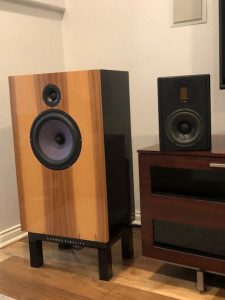
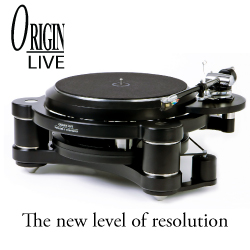 However, with comparison, one can readily come up with sins of omission. They don’t quite have the scale and sweep of larger speakers like the Devore Super Nines I had here recently or the Dali Oberon 7’s I had here for a time, or certainly of my current Devore 0/96s. Nor do they, by extension (pun intended!), have the bass extension and dynamism of such designs. That’s where my trusty Rel T/7x came in, and handily so. With the T/7x in play, the Acelec becomes a BIG BOY speaker, detailed to the nines (pun intended!) and as free of coloration top to bottom as any transducer I’ve ever heard.
However, with comparison, one can readily come up with sins of omission. They don’t quite have the scale and sweep of larger speakers like the Devore Super Nines I had here recently or the Dali Oberon 7’s I had here for a time, or certainly of my current Devore 0/96s. Nor do they, by extension (pun intended!), have the bass extension and dynamism of such designs. That’s where my trusty Rel T/7x came in, and handily so. With the T/7x in play, the Acelec becomes a BIG BOY speaker, detailed to the nines (pun intended!) and as free of coloration top to bottom as any transducer I’ve ever heard.
However, they also are not quite as alive and free-flowing as a larger higher efficiency speaker like a Super Nine or O/96 or, for that matter, as my higher efficiency Xavian Perla Esclusiva monitors. All of these, though, might be strictly speaking more ‘colored’ than the Acelec, and you have to like that color. The Acelecs were certainly passable at late-night listening levels, though I did not find them exceptional in this regard. If most of your listening is late-night when the dog and/or cat is asleep, it could be a consideration, though, and a higher efficiency speaker that comes to life a bit better at lower levels might be in order. I caveat this with the conjecture that more muscular amps like a Bryston or a Burson etc., might have given even better results in this regard, but the Acelec and, for that matter, my Xavian monitors, are unlikely to offer the BSE (Big Speaker Energy) or micro-dynamics of an O/96, especially at lower levels.
 Such speakers have a way with lower level micro-dynamics and flow due to their ease of drive that I have found lower efficiency smaller speakers as a species generally cannot match. On the other hand, such larger high-eff speakers are by turns shy of the precision, accuracy, and utter freedom from the bounds of boxiness the Acelec has on offer. But you have to want that; an almost monitor-like linearity. You also have to want to marry a (very) directional tweeter, which means toe-in is de rigueur. In fact, this means, unlike many speakers to which I am accustomed, where zero toe-in is actually recommended(!), you have to point the Acelecs much closer to at you to get all of the considerable treble detail and delicacy they have to offer.
Such speakers have a way with lower level micro-dynamics and flow due to their ease of drive that I have found lower efficiency smaller speakers as a species generally cannot match. On the other hand, such larger high-eff speakers are by turns shy of the precision, accuracy, and utter freedom from the bounds of boxiness the Acelec has on offer. But you have to want that; an almost monitor-like linearity. You also have to want to marry a (very) directional tweeter, which means toe-in is de rigueur. In fact, this means, unlike many speakers to which I am accustomed, where zero toe-in is actually recommended(!), you have to point the Acelecs much closer to at you to get all of the considerable treble detail and delicacy they have to offer.
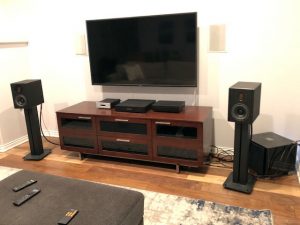
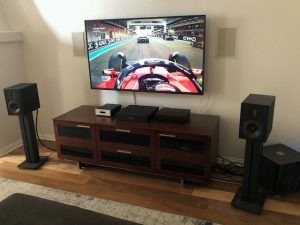
This means a bit of a narrower sweet spot than, say, a Dali speaker with no need for toe-in. It’s not a razor-thin sweet spot, mind you- perfectly enjoyable off-axis for TV, etc., just a bit narrower than a wider dispersion speaker. But… BUT!! As I found out, in return, you gain a certain freedom from room interactions, notably with sidewalls, which can be most welcome; neigh, addictive! I, for one, loved it!
As I write this, my room, for example, is in the process of being acoustically measured and having suitable treatment recommendations made (shout out to Jeff Hedback of https://www.hdacoustics.net/— try him yourself!) for some excess high-frequency decay issues contributing to an ongoing struggle with edginess as well as for some apparent jaggedness/spikiness in the low-frequency response. Some speakers I’ve had, in particular, bring such anomalies forth, including my Devore Super Nines and the Dalis. Basically, any speaker that throws sound broadly from a narrow baffle, of which minimal toe-in is required, will, of course, excite room issues, particularly in the mid to high range, more so than one that ‘beams’ sound at you in a narrower arc. The Acelecs, in this way, can offer blessed relief from negative room contributions, and that’s what they did for me! The treble energy my untreated room reflects was much less present with the Acelecs playing tunes, meaning I was free to hear their remarkably lucid top end without my room having as much of a say in the matter. That bad partially treated sidewall asymmetry/reflection I found, along with its attendant hardness? Largely gone! No (or minimal) acoustic treatments are needed! If I were to live with the Acelecs, I could save quite a bit on unsightly wall panels (and maybe bass traps, as I’d likely use a pair of subs with them).

Here too, in the process, they also showed me the inherent superiority of the Innuos Pulse streamer I was demoing (and ultimately decided to buy) courtesy of the very congenial and knowledgeable Mike Garner at tweekgeek.com. There was simply slightly more of everything with the Innuos here, namely detail, air, stage, and bass, than with my 2014 Mac Mini and Audirvana. In this regard, the Acelecs were instrumental in my ultimate decision to discern the superiority of (and ultimately purchase) the Innuos, and I thank them for that 🙂
Throughout the review, I kept wishing for ‘more power captain,’ but not because I needed it for volume: far from it. I could deafen myself at will with 40 watts. I simply wanted to see if the Acelecs could be even better micro-dynamically speaking at low-volume late-night listening, as I often love listening when everyone else is asleep. The Devore Super Nines and 0/96s I have here pull that trick off beautifully, and so do my Xavian monitors. All are more efficient and a bit easier to drive.
Summations and Conclusions
The Acelec model One loudspeakers are a tour de force of sound speaker engineering from the same man/company that brought you the much loved Metrum digital gear and now, Sonnet. If you look at the speaker’s specs and construction; thick bituminized damped aluminum billet, Air Motion Transducer, and pricey Scan-Speak woofer with primo crossover parts and a super-linear very (very) objectivist friendly on-axis frequency response, the sum the Acelec sells for seems a relative bargain.
I don’t mean to compare with things I don’t have much (any?) experience with, but many very high-end speakers eschew MDF or HDF construction for solid aluminum boxes, and they all give the same reasoning; resonance control. The Acelecs use the same ways and means as some of these uber-pricey transducers to a similar end; measurable linearity and coherence. They are ‘straight no chaser’ monitor-like speakers serving up a heady dose of perceived ‘box-less’ accuracy and tonal neutrality without seemingly biting the hand (or the ear) that sits before them.
They are relatively easy to place (as long as you toe them in toward you wherever they end up) and pair beautifully with a sub to provide a bit more of that BSE mentioned above (yeah, I’m trying to make the acronym a thing; what of it?).
Due to their sonic honesty, these Acelecs have already found favor and even a home with a number of reviewers thus far, and if you seek a smaller speaker with a superbly linear frequency response that will hardly betray any hint of the non-resonant box its drivers live in, while at the same time minimizing the deleterious effects your room is having on your sound, I think the Acelecs would be one to take home to momma.
I bid you peace
david abramson
Specifications: Acelec Model One
Retail price: 6495.00
System Format: 2-way
Housing: 15 mm bituminized aluminum
Bass Alignment: Low Q alignment Vented port system.
Frequency Response (-6 dB): 45 Hz – 35 kHz, Max. deviation ± 2.5 dB
Sensitivity (1W@1M): 84 dB
Nominal Impedance: 8 ohms
Minimum Impedance: 5 ohms at 375 Hz
Maximum SPL: 110 dBA (Pair)
Power Handling (RMS): 120 W
Recommended Amplifier Requirements: 25 – 100 W
Crossover Frequency: 1.8 kHz
Drive Unit Complement: 15cm bass / mid transducer, 18 mmAir Motion Transformer
Cabinet Dimensions (H x W x D): 285 x 195 x 300 mm
Finish: Silver or black finish
Weight: 17 kg
Contact: Audio Art Cable
David’s Associated Equipment
Digital source:
Innuos Pulse streamer; Mac Mini 2014 w/Roon and Audirvana Studio; Holo Audio KTE May DAC
Amplification:
Lejonklou Boazu integrated amplifier; Linear Tube Audio MZ3 preamp; First Watt SIT 3 power amp;
Loudspeakers:
Devore Super Nines; Devore 0/96’s; Xavian Perla Esclusivas
Cables:
Audio Art Cable Statement e SC Cryo speaker wires; Belden 8402 interconnects; Audioquest Carbon USB cable
Accessories:
Symposium Svelte Shelf Plus and Rollerblock Jr. footers (under Holo KTE May DAC)
Stereo Times Masthead
Publisher/Founder
Clement Perry
Editor
Dave Thomas
Senior Editors
Frank Alles, Mike Girardi, Russell Lichter, Terry London, Moreno Mitchell, Paul Szabady, Bill Wells, Mike Wright, and Stephen Yan,
Current Contributors
David Abramson, Tim Barrall, Dave Allison, Ron Cook, Lewis Dardick, John Hoffman, Dan Secula, Don Shaulis, Greg Simmons, Eric Teh, Greg Voth, Richard Willie, Ed Van Winkle, Rob Dockery, Richard Doron, and Daveed Turek
Site Management Clement Perry
Ad Designer: Martin Perry





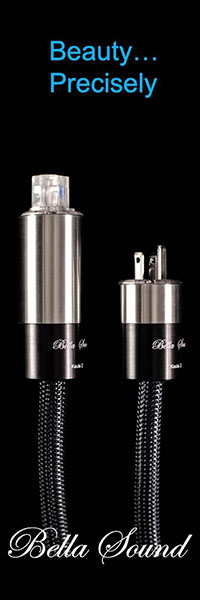

Be the first to comment on: Acelec Model One Loudspeakers by David Abramson